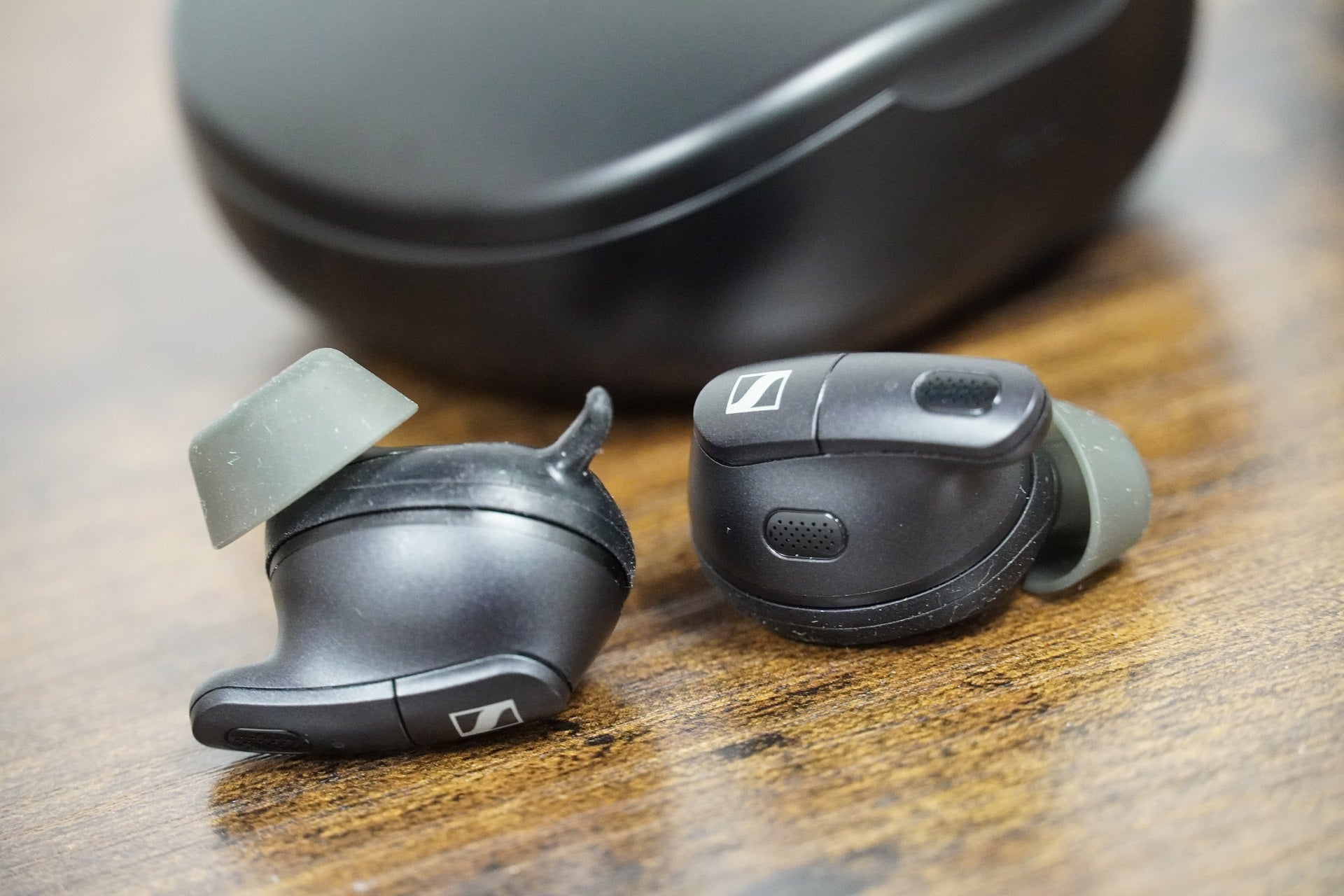A noble idea from Sennheiser, but the execution is off, and the price tag is enormously high.
Pros
- Improves clarity of people’s voices
- Effective noise cancellation
- Call quality is very good
- Simple to use app
Cons
- Not great with music playback
- Can be uncomfortable to wear
- Transparency mode is not the clearest
- High price tag
- Can hit sibilant notes with people’s voices
Availability
- UKRRP: £749
- USARRP: $849.95
- EuropeRRP: €849
- CanadaTBC
- AustraliaTBC
-
Clearer conversationsEnhances clarity of people speaking around you -
Noise cancellingANC and transparency mode supported
Introduction
Hearing loss is a silent issue, one affecting many adults – but as a topic, it hasn’t received the attention it merits.
Hearing loss is inevitable as we get older, but finding you have an issue and doing something about it has, historically, taken longer than it needs to. Help is on the way though, with several headphone brands looking to take leadership in that area.
One of those brands is Sennheiser. It launched several products in recent years to enhance the clarity of the interactions you have every day with people and devices in the home.
The Conversation Clear Plus is a wearable that allows you to better understand what your friends and family are saying and is equipped with noise cancellation to block out sounds when you want to reduce the noise and give your ears some protection.
Design
- Chunky looks
- Tight fit
- Physical buttons
The wingtips and ear adapters give the Conversation Clear Plus an almost insect-like appearance, not unlike the Rock Jaw Avant Air. They’re bulky but they fit into my ear and don’t shift about, with replaceable wingtips and adapters (small, medium, large) for the best fit.
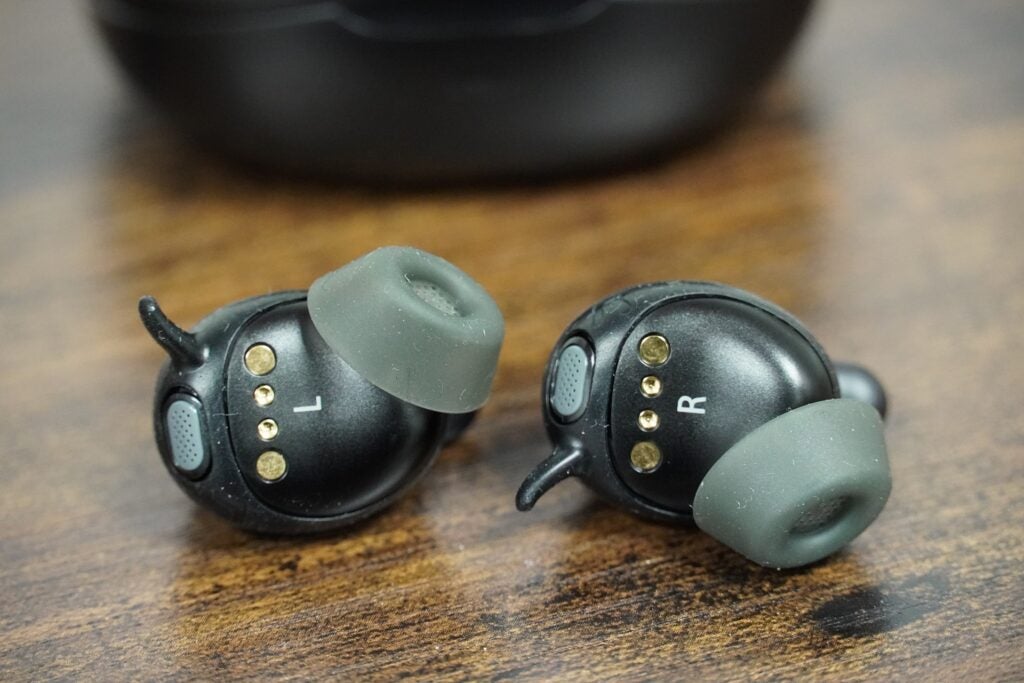
Despite the security of the fit, comfort is an area I found to be a mixed bag. The plastic housing doesn’t offer the gentlest point of contact, a point exacerbated by cold weather during the test period. These aren’t buds where their presence is forgotten when inserted, but they’re also not the most intrusive pair either.
The plastic nature of the housing gives the Sennheiser a cheaper feel than its steep price tag suggests. The controls – physical buttons at that – are manageable enough for playback, switching between modes (more on that later) and taking calls, though there is a lot to keep track of as there are short presses, holds and double taps to remember.
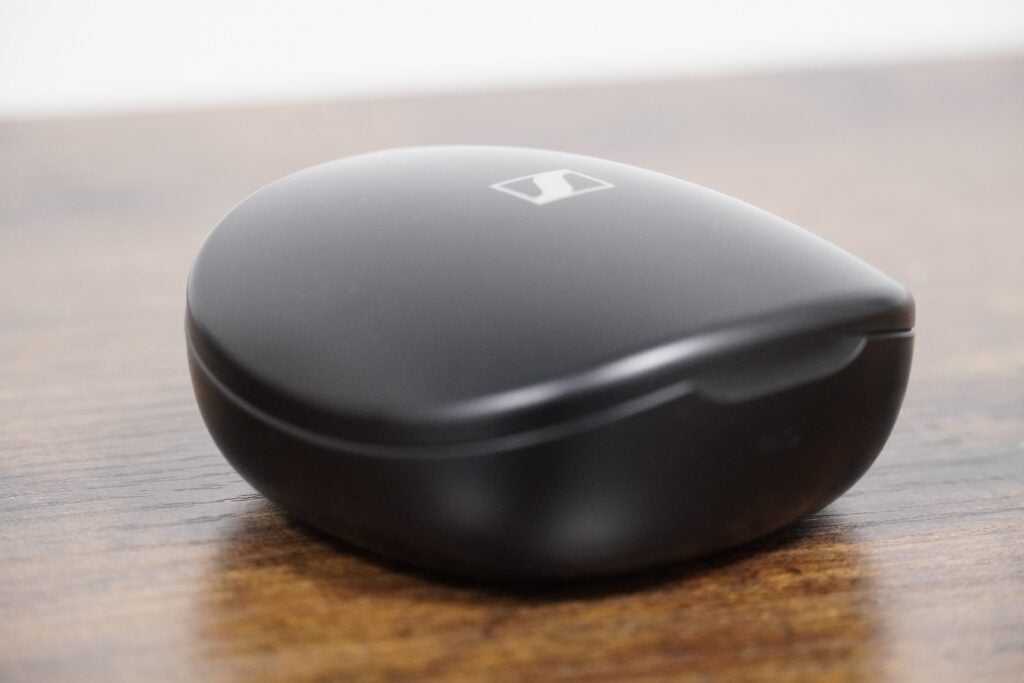
The clamshell charging case (also decked in black) is fairly big, certainly not one you’d slip into a tight pocket though anything else should be ok. There’s a USB-C port for charging around the back, though no Bluetooth pairing button as that’s managed by the controls onboard.
Features
- Noise-cancellation and transparency modes
- Bluetooth (SBC) audio
- Conversation Clear app
The Conversation Clear Plus support three different modes: Relax, Communication and Stream. The first is where noise cancellation comes into play, the second allows surrounding sounds to pour through and the third is for audio playback. Between all these modes you can alter the strength of the noise cancellation, the volume level of speech or the balance between ambience and noise cancelling respectively.
The thinking behind how switching works is muddled. Switching between Relax and Communication is simple – a hold on the right or left bud depending on which mode you’re in swaps between them – but the Stream mode is an afterthought, accessible only through the Conversation Clear app.
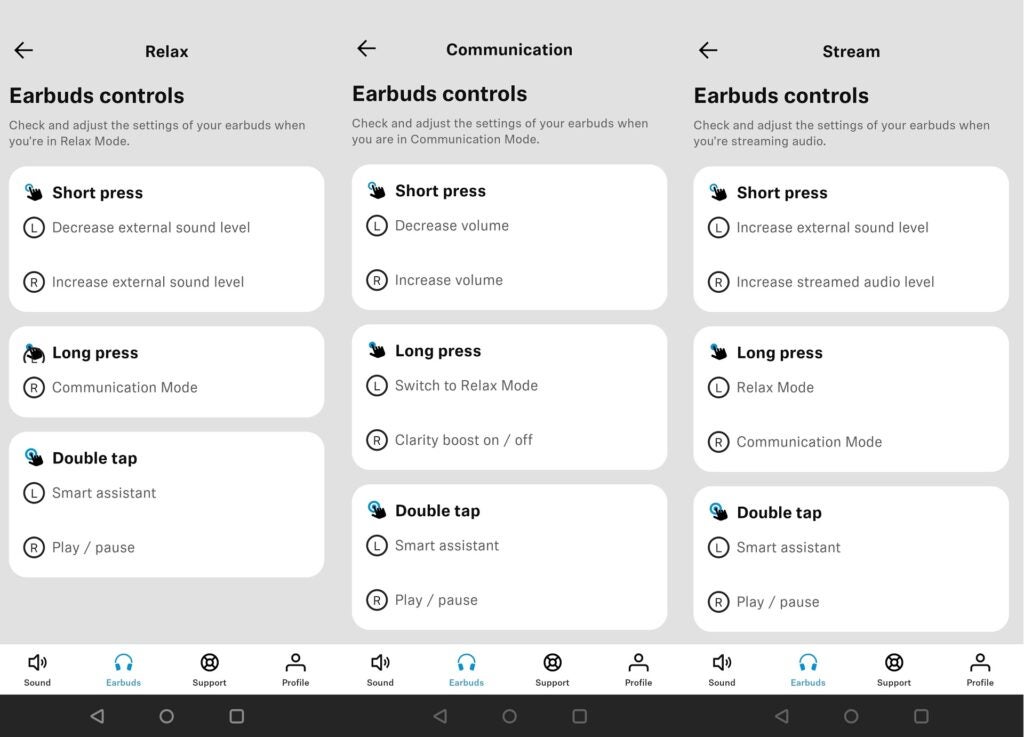
It’s not a surprise Sennheiser is putting the emphasis on enhancing conversation clarity as these buds’ main point and music playback far behind. But it’s inconvenient if you were to use the earphones for music playback by relegating the function to the app given how easy it would be able to do.
It’d also be a lot more convenient if there was a voice confirming the mode or action you’ve completed instead of chirpy tones and chimes, which aren’t particularly useful in remembering the mode you’re in or what you’ve done, especially given the audience this is pitched at.
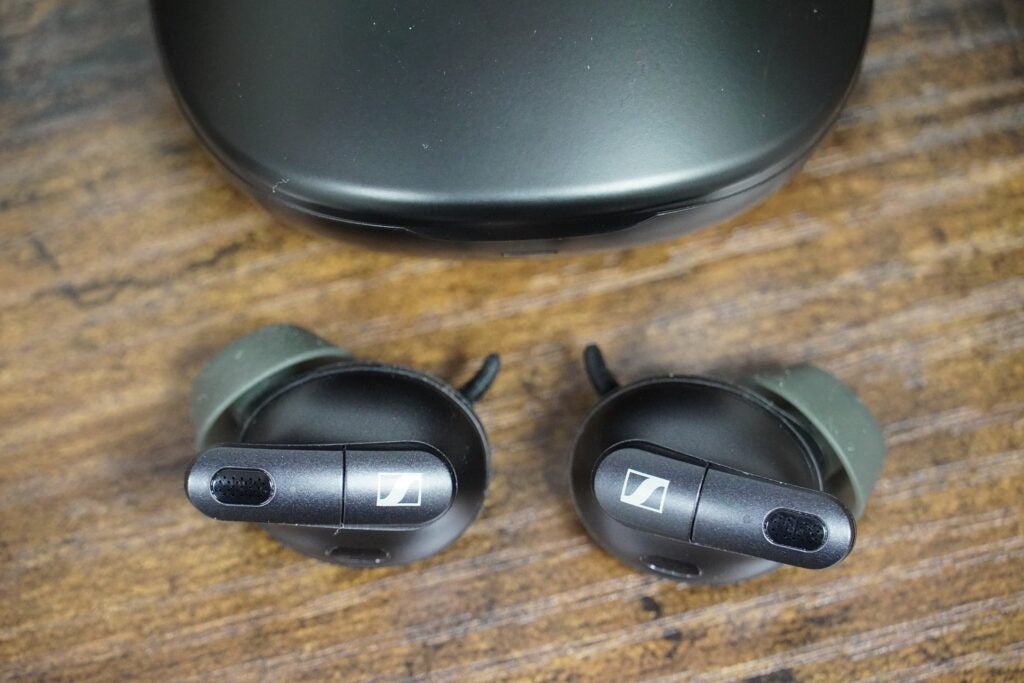
Bluetooth is v4.2 with SBC codec support, and while the connection has been fine when used in pubs and offices, walking through Waterloo did cause a spotty connection.
Battery life is rated at nine hours and 27 in total with the charging case (two extra charges). Given the Conversation Clear Plus’ many use cases I don’t think it would be fair to judge its battery life on streaming audio alone but battery life, in general, was solid throughout testing. There’s no wireless charging as the case’s reserves are boosted by a USB-C connection.
The Conversation Clear app is separate from Sennheiser’s Smart Control app for its headphones, and in use, each section is easy to understand, the interface sensibly laid out and the sliders to change noise-cancelling and ambient modes intuitive enough to easily manipulate.
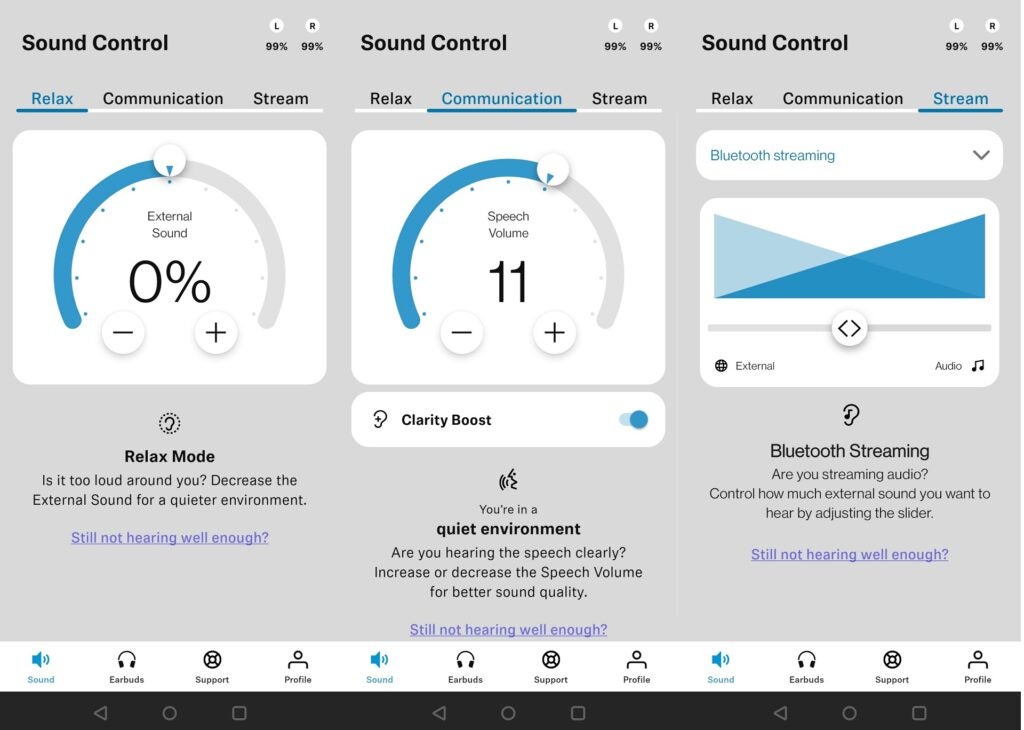
The feedback provided is helpful too. In the Communication section, the app will tell you how noisy it thinks the environment you’re in is and adjust the strength of the noise cancellation in response. Opening the app and there is a slight pause for the app and buds to recognise each other. I’d hope for a more instant connection.
The app/earbuds can switch between modes on its own with its Automatic Scene Detection, but the execution is also a mixed bag. The feature constantly monitors noise level but that also means it’s constantly switching between various noise cancelling levels, those little chimes become more frequent if you’re in a busy setting, and after a while it distracts.
Performance
- Effective noise-cancelling
- Noisy signal with music
- Does make people’s voices more intelligible
The noise cancellation proves to be effective in its levels of suppression, keeping unwanted noises away. Using the Sennheisers in an office setting, they reduce the noise of a chattering motorbike outside, and the sound of staff members talking is less of a distraction.
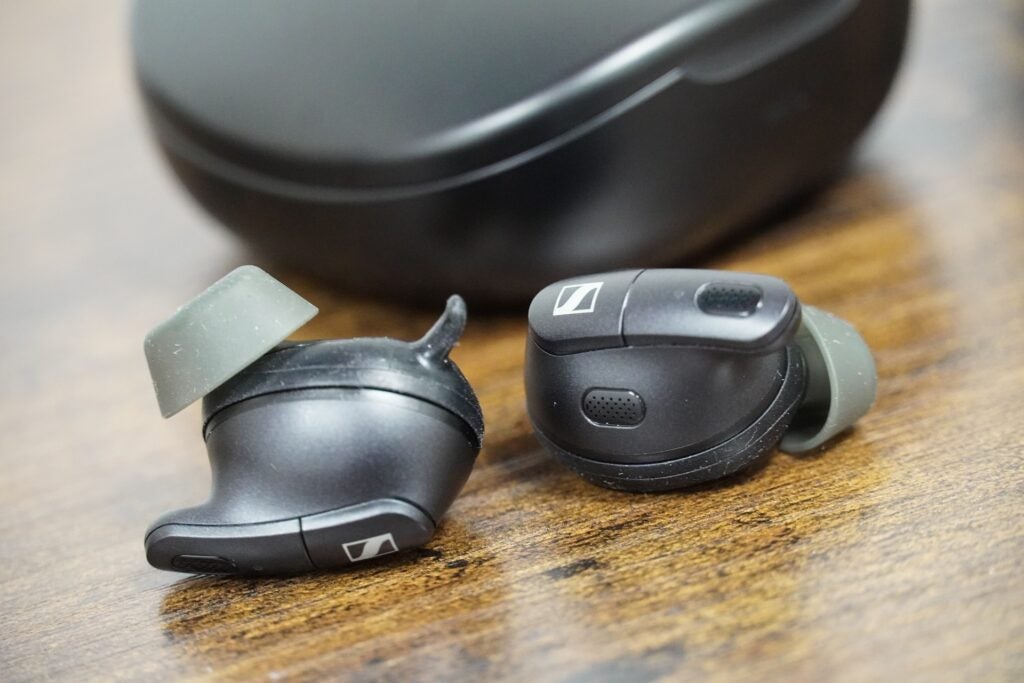
When used outside it’s a solid buffer on transportation on the streets of London. The transparency mode (which you can switch into by adjusting the slider in the Relax mode) is not the clearest sounding effort. There’s a strange distortion (like what I remember from the Lypertek SoundFree S20) that produces an unnatural hum. Despite that, it does latch on to voices well.
Which offers a nice segue into the Communication mode. Switch to this mode and voices are more audible and there’s better awareness of what’s around me. Trying them in a pub, they hit the mark in terms of improving the vocal clarity of others.
I often struggle to hear what people are saying in loud environments, rarely catching all the words of what people further away are saying, and so the Conversation Clear Plus helped elevate voices and reduce the background noise to make their words more intelligible. The Clarity Boost focuses on voices even further.
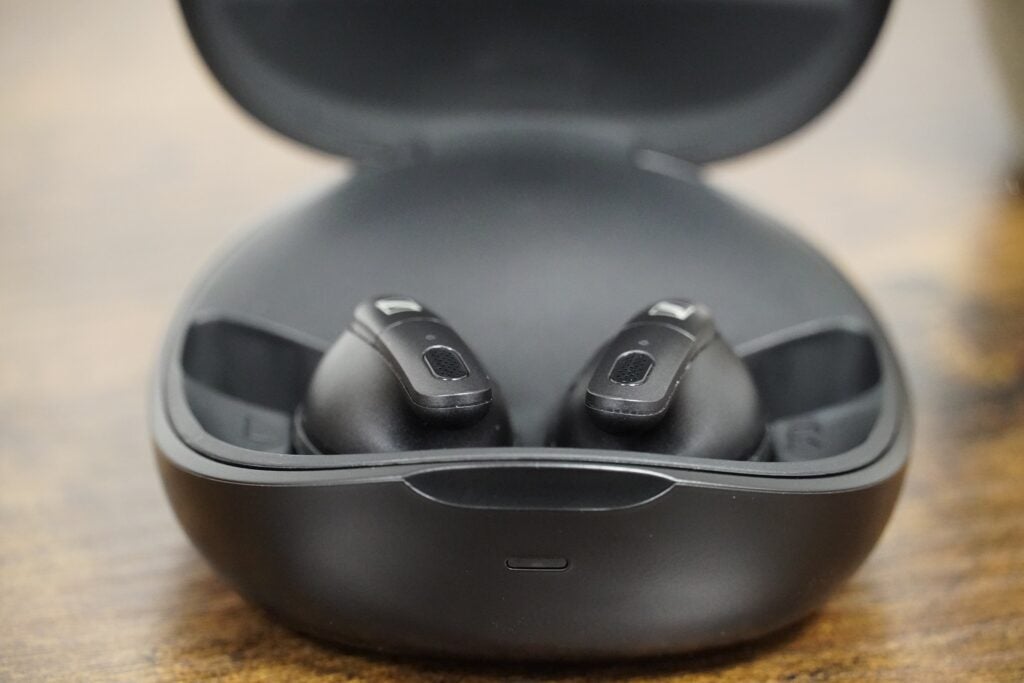
Nevertheless, there’s still an unnatural tone to some voices. Some people sounded fine and much like themselves, while others sounded sharper, treading on sibilance (particularly with a female voice) and making their voice sound strained.
The Conversation Clear Plus also picked up lyrics from music in the pub too, which would sometimes mix with what people close by were saying. Then there were times when the pub became really loud and everything merged as one, but I will say it was better to be wearing the Sennheisers as without them the pub was unbearably loud.
With music and to a lesser degree TV, there’s signal noise to deal with that affects clarity. In general, retrieval of detail when listening to Spotify or Tidal is ok, but there’s a lack of definition, dynamism and sharpness that contributes to a fuzzy soundstage.
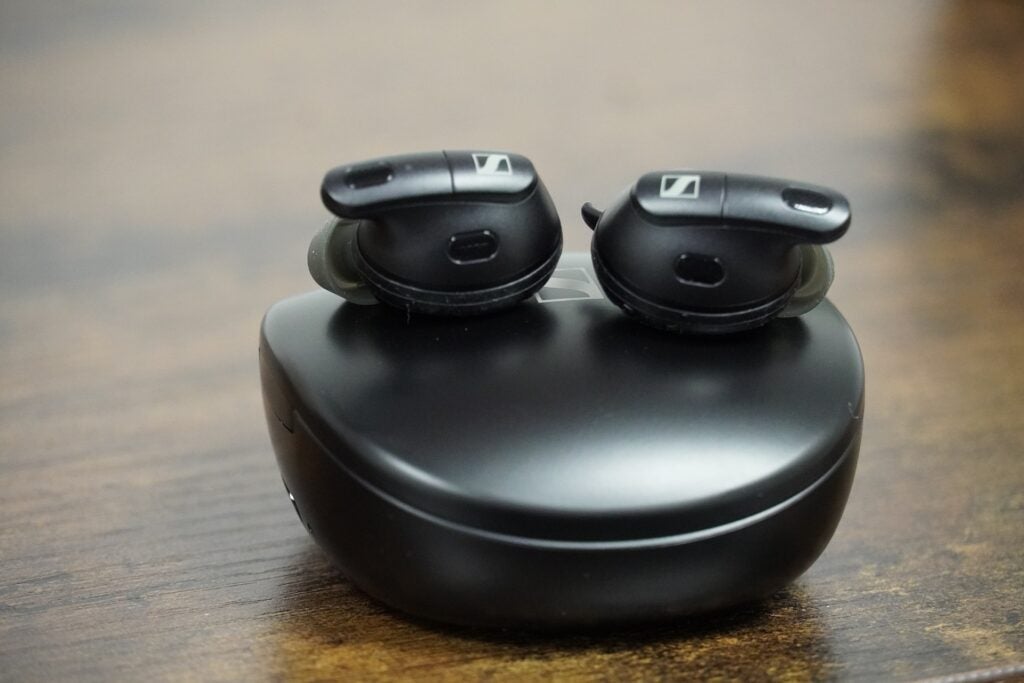
It’s a similar case with TV. Watching Stranger Things in Spatial Audio and bass has a big presence, but it’s also rather flatly described. It’s not the subtlest or spacious performance, and there is a lack of dynamism (especially notable when music comes to a crescendo in one scene). It does, at least, sift out dialogue with clarity.
It’s more comfortable with less demanding tracks: streaming My5, watching Tastemade or the film Chef, striking a normal and clearer tone. And when it senses there’s no audio (say when I’m in the Fire TV menus), it instantly switches to Communication mode and when it picks up audio, switches back to Stream mode. That can get annoying when flicking through menus.
Finally is call quality, which is very good. With the help of the noise-cancellation it keeps most sounds at bay, lightly suppressing my voice when dealing with loud noises. The person on the other end said my voice always came through clearly and that background noises only posed a slight distraction.
Latest deals
Should you buy it?
If you struggle to hear others in loud environments: In terms of their purpose for existing, the Conversation Clear Plus do work as advertise, though it comes with a few caveats.
The performance isn’t there and the price is too high: £749 is a lot to pay to improve the clarity of your voices, and their audio playback isn’t good enough to justify using with music or TV.
Final Thoughts
On the one hand, the Sennheiser Conversation Clear Plus work as advertised, the noise cancellation is effective, and they’re easy to use. On the other, there is the consideration of its hefty price, the sub-par music playback and comfort issues.
It’s an enormous amount of money to pay for a wearable, especially one that sees music playback low down the list of priorities. Would you fork over this amount of money to help enhance conversations? I don’t think you would, and with other competitors in the same space such as Philips set to release rival buds at much lower prices, it does seem a lot to pay.
The idea here is laudable, but the execution is off, and the price tag weighs heavy on the Sennheiser. I don’t think the performance of the Conversation Clear Plus is enough to merit the £749 asking price.
How we test
We test every set of headphones we review thoroughly over an extended period of time. We use industry standard tests to compare features properly. We’ll always tell you what we find. We never, ever, accept money to review a product.
Find out more about how we test in our ethics policy.
Tested with real world use
FAQs
These Sennheiser earphones don’t support the Auracast feature that’s become a part of the Bluetooth 5.3 codec. Sennheiser says it has other plans to provide a similar support.
The Conversation Clear Plus are not hearing aids, instead considered to enhance hearing so the wearer can listen to conversations be had with more clarity. They haven not been medically certified to be considered as hearing aids.
Jargon buster
Bluetooth
Bluetooth – named after 10th-century Danish king Harald Bluetooth who united Denmark’s tribes into a single kingdom – is a method of wireless transmission that allows for the exchange of data between devices over short distances.
A noble idea from Sennheiser, but the execution is off, and the price tag is enormously high.
Pros
- Improves clarity of people’s voices
- Effective noise cancellation
- Call quality is very good
- Simple to use app
Cons
- Not great with music playback
- Can be uncomfortable to wear
- Transparency mode is not the clearest
- High price tag
- Can hit sibilant notes with people’s voices
Availability
- UKRRP: £749
- USARRP: $849.95
- EuropeRRP: €849
- CanadaTBC
- AustraliaTBC
-
Clearer conversationsEnhances clarity of people speaking around you -
Noise cancellingANC and transparency mode supported
Introduction
Hearing loss is a silent issue, one affecting many adults – but as a topic, it hasn’t received the attention it merits.
Hearing loss is inevitable as we get older, but finding you have an issue and doing something about it has, historically, taken longer than it needs to. Help is on the way though, with several headphone brands looking to take leadership in that area.
One of those brands is Sennheiser. It launched several products in recent years to enhance the clarity of the interactions you have every day with people and devices in the home.
The Conversation Clear Plus is a wearable that allows you to better understand what your friends and family are saying and is equipped with noise cancellation to block out sounds when you want to reduce the noise and give your ears some protection.
Design
- Chunky looks
- Tight fit
- Physical buttons
The wingtips and ear adapters give the Conversation Clear Plus an almost insect-like appearance, not unlike the Rock Jaw Avant Air. They’re bulky but they fit into my ear and don’t shift about, with replaceable wingtips and adapters (small, medium, large) for the best fit.

Despite the security of the fit, comfort is an area I found to be a mixed bag. The plastic housing doesn’t offer the gentlest point of contact, a point exacerbated by cold weather during the test period. These aren’t buds where their presence is forgotten when inserted, but they’re also not the most intrusive pair either.
The plastic nature of the housing gives the Sennheiser a cheaper feel than its steep price tag suggests. The controls – physical buttons at that – are manageable enough for playback, switching between modes (more on that later) and taking calls, though there is a lot to keep track of as there are short presses, holds and double taps to remember.

The clamshell charging case (also decked in black) is fairly big, certainly not one you’d slip into a tight pocket though anything else should be ok. There’s a USB-C port for charging around the back, though no Bluetooth pairing button as that’s managed by the controls onboard.
Features
- Noise-cancellation and transparency modes
- Bluetooth (SBC) audio
- Conversation Clear app
The Conversation Clear Plus support three different modes: Relax, Communication and Stream. The first is where noise cancellation comes into play, the second allows surrounding sounds to pour through and the third is for audio playback. Between all these modes you can alter the strength of the noise cancellation, the volume level of speech or the balance between ambience and noise cancelling respectively.
The thinking behind how switching works is muddled. Switching between Relax and Communication is simple – a hold on the right or left bud depending on which mode you’re in swaps between them – but the Stream mode is an afterthought, accessible only through the Conversation Clear app.

It’s not a surprise Sennheiser is putting the emphasis on enhancing conversation clarity as these buds’ main point and music playback far behind. But it’s inconvenient if you were to use the earphones for music playback by relegating the function to the app given how easy it would be able to do.
It’d also be a lot more convenient if there was a voice confirming the mode or action you’ve completed instead of chirpy tones and chimes, which aren’t particularly useful in remembering the mode you’re in or what you’ve done, especially given the audience this is pitched at.

Bluetooth is v4.2 with SBC codec support, and while the connection has been fine when used in pubs and offices, walking through Waterloo did cause a spotty connection.
Battery life is rated at nine hours and 27 in total with the charging case (two extra charges). Given the Conversation Clear Plus’ many use cases I don’t think it would be fair to judge its battery life on streaming audio alone but battery life, in general, was solid throughout testing. There’s no wireless charging as the case’s reserves are boosted by a USB-C connection.
The Conversation Clear app is separate from Sennheiser’s Smart Control app for its headphones, and in use, each section is easy to understand, the interface sensibly laid out and the sliders to change noise-cancelling and ambient modes intuitive enough to easily manipulate.

The feedback provided is helpful too. In the Communication section, the app will tell you how noisy it thinks the environment you’re in is and adjust the strength of the noise cancellation in response. Opening the app and there is a slight pause for the app and buds to recognise each other. I’d hope for a more instant connection.
The app/earbuds can switch between modes on its own with its Automatic Scene Detection, but the execution is also a mixed bag. The feature constantly monitors noise level but that also means it’s constantly switching between various noise cancelling levels, those little chimes become more frequent if you’re in a busy setting, and after a while it distracts.
Performance
- Effective noise-cancelling
- Noisy signal with music
- Does make people’s voices more intelligible
The noise cancellation proves to be effective in its levels of suppression, keeping unwanted noises away. Using the Sennheisers in an office setting, they reduce the noise of a chattering motorbike outside, and the sound of staff members talking is less of a distraction.

When used outside it’s a solid buffer on transportation on the streets of London. The transparency mode (which you can switch into by adjusting the slider in the Relax mode) is not the clearest sounding effort. There’s a strange distortion (like what I remember from the Lypertek SoundFree S20) that produces an unnatural hum. Despite that, it does latch on to voices well.
Which offers a nice segue into the Communication mode. Switch to this mode and voices are more audible and there’s better awareness of what’s around me. Trying them in a pub, they hit the mark in terms of improving the vocal clarity of others.
I often struggle to hear what people are saying in loud environments, rarely catching all the words of what people further away are saying, and so the Conversation Clear Plus helped elevate voices and reduce the background noise to make their words more intelligible. The Clarity Boost focuses on voices even further.

Nevertheless, there’s still an unnatural tone to some voices. Some people sounded fine and much like themselves, while others sounded sharper, treading on sibilance (particularly with a female voice) and making their voice sound strained.
The Conversation Clear Plus also picked up lyrics from music in the pub too, which would sometimes mix with what people close by were saying. Then there were times when the pub became really loud and everything merged as one, but I will say it was better to be wearing the Sennheisers as without them the pub was unbearably loud.
With music and to a lesser degree TV, there’s signal noise to deal with that affects clarity. In general, retrieval of detail when listening to Spotify or Tidal is ok, but there’s a lack of definition, dynamism and sharpness that contributes to a fuzzy soundstage.

It’s a similar case with TV. Watching Stranger Things in Spatial Audio and bass has a big presence, but it’s also rather flatly described. It’s not the subtlest or spacious performance, and there is a lack of dynamism (especially notable when music comes to a crescendo in one scene). It does, at least, sift out dialogue with clarity.
It’s more comfortable with less demanding tracks: streaming My5, watching Tastemade or the film Chef, striking a normal and clearer tone. And when it senses there’s no audio (say when I’m in the Fire TV menus), it instantly switches to Communication mode and when it picks up audio, switches back to Stream mode. That can get annoying when flicking through menus.
Finally is call quality, which is very good. With the help of the noise-cancellation it keeps most sounds at bay, lightly suppressing my voice when dealing with loud noises. The person on the other end said my voice always came through clearly and that background noises only posed a slight distraction.
Latest deals
Should you buy it?
If you struggle to hear others in loud environments: In terms of their purpose for existing, the Conversation Clear Plus do work as advertise, though it comes with a few caveats.
The performance isn’t there and the price is too high: £749 is a lot to pay to improve the clarity of your voices, and their audio playback isn’t good enough to justify using with music or TV.
Final Thoughts
On the one hand, the Sennheiser Conversation Clear Plus work as advertised, the noise cancellation is effective, and they’re easy to use. On the other, there is the consideration of its hefty price, the sub-par music playback and comfort issues.
It’s an enormous amount of money to pay for a wearable, especially one that sees music playback low down the list of priorities. Would you fork over this amount of money to help enhance conversations? I don’t think you would, and with other competitors in the same space such as Philips set to release rival buds at much lower prices, it does seem a lot to pay.
The idea here is laudable, but the execution is off, and the price tag weighs heavy on the Sennheiser. I don’t think the performance of the Conversation Clear Plus is enough to merit the £749 asking price.
How we test
We test every set of headphones we review thoroughly over an extended period of time. We use industry standard tests to compare features properly. We’ll always tell you what we find. We never, ever, accept money to review a product.
Find out more about how we test in our ethics policy.
Tested with real world use
FAQs
These Sennheiser earphones don’t support the Auracast feature that’s become a part of the Bluetooth 5.3 codec. Sennheiser says it has other plans to provide a similar support.
The Conversation Clear Plus are not hearing aids, instead considered to enhance hearing so the wearer can listen to conversations be had with more clarity. They haven not been medically certified to be considered as hearing aids.
Jargon buster
Bluetooth
Bluetooth – named after 10th-century Danish king Harald Bluetooth who united Denmark’s tribes into a single kingdom – is a method of wireless transmission that allows for the exchange of data between devices over short distances.



















